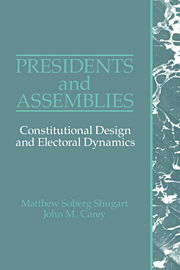Book contents
- Frontmatter
- Contents
- List of tables and figures
- Acknowledgments
- 1 Basic choices in democratic regime types
- 2 Defining regimes with elected presidents
- 3 Criticisms of presidentialism and responses
- 4 The premier-presidential and president-parliamentary experiences
- 5 The constitutional origins of chief executives
- 6 Constitutional limits on separate origin and survival
- 7 Legislative powers of presidents
- 8 Assessing the powers of the presidency
- 9 Electoral dynamics: efficiency and inefficiency
- 10 Electoral rules and the party system
- 11 Electoral cycles and the party system
- 12 Electoral cycles and compatibility between president and assembly
- 13 Conclusions
- Appendix A Electoral rules for one-seat districts and coalition-building incentives
- Appendix B Theoretical explanation for models predicting number of parties in presidential systems
- Bibliography
- Index
Appendix A - Electoral rules for one-seat districts and coalition-building incentives
Published online by Cambridge University Press: 05 June 2012
- Frontmatter
- Contents
- List of tables and figures
- Acknowledgments
- 1 Basic choices in democratic regime types
- 2 Defining regimes with elected presidents
- 3 Criticisms of presidentialism and responses
- 4 The premier-presidential and president-parliamentary experiences
- 5 The constitutional origins of chief executives
- 6 Constitutional limits on separate origin and survival
- 7 Legislative powers of presidents
- 8 Assessing the powers of the presidency
- 9 Electoral dynamics: efficiency and inefficiency
- 10 Electoral rules and the party system
- 11 Electoral cycles and the party system
- 12 Electoral cycles and compatibility between president and assembly
- 13 Conclusions
- Appendix A Electoral rules for one-seat districts and coalition-building incentives
- Appendix B Theoretical explanation for models predicting number of parties in presidential systems
- Bibliography
- Index
Summary
We saw in Chapter 10 that in Costa Rica, the rule requiring a candidate to obtain at least 40% of the vote or else face a runoff has led to a pattern of competition almost identical to that seen in straight plurality presidential systems. The Costa Rican rule thus contrasts rather starkly with majority provisions, in which there is a runoff in the event that no candidate obtains at least 50% plus one of the votes. In such majority runoff systems, the vote shares of the first and second finishers in the first round tend to be considerably lower than in plurality rules, including the Costa Rican variant.
Is this outcome fortuitous, or is there something to the 40% rule that encourages broad preelection coalitions as does pure plurality? This question is worth investigating, especially given that there is only one case of a system using the 40% rule. Perhaps Costa Rica, where a runoff has never been required, is a special case because of its single well-organized mass party, the Party of National Liberation (PLN). Perhaps this party has a “natural” share of the vote that approximates 50% anyway. If so, it might ordinarily win elections (which it certainly does), and it could only lose to a united opposition – that is, one that could itself approach the magical 50% mark. Indeed, in six of the ten elections since 1958, the PLN has obtained an absolute majority.
- Type
- Chapter
- Information
- Presidents and AssembliesConstitutional Design and Electoral Dynamics, pp. 288 - 292Publisher: Cambridge University PressPrint publication year: 1992



